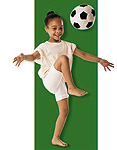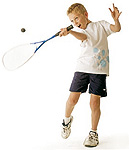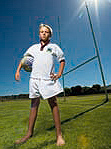Whether your child is the next sports superstar or not, good ball skills and hand-eye coordination will help in other fields too – even in maths. Fortunately there’s a lot you can do to develop these skills.
By Carine Visagie for YOU Pulse magazine
Soccer balls, tennis balls, colourful beach balls or quirky bouncy balls – get them out and start kicking, throwing and rolling. It will benefit your child in countless ways.
Being able to handle a ball well can lead to a lifetime of enjoyable participation in sports as well as better health. Who knows, you may even be raising a sports superstar! But it’s not only about sport and action – good ball sense is just one of the results of good hand-eye and foot-eye coordination.
Children also need good coordination skills to carry out simple tasks such as getting dressed, putting toothpaste on a toothbrush and pouring juice.
This leads to mastering more complicated activities such as playing video games, colouring in, cutting with scissors, writing with a pen or pencil, using a computer mouse and developing spatial awareness – all of which are important skills for mathematics. So this is serious stuff!
While ball sense is something one is born with, it can also be developed and improved, says Anne van Niekerk of Playball, a sports programme arranged through schools. Playball has a fun approach to physical training: the goal is to improve children’s ball skills – and therefore handeye and foot-eye coordination – while they take part in fun activities.
‘‘Just remember that children’s development phases are not set in stone,’’ says Dana-Anne Katz, a Cape Town occupational therapist. ‘‘All children develop skills in their own time and some will be more skilled in certain areas than others.’’
Give your children the edge with the help of our milestone guide and a few valuable tips for improving their ball sense:
AGE 2
What children can do
The development of ball skills involves much more than just learning to throw, catch or kick a ball. At this stage the most important priority is to encourage crawling and weight-bearing using the arms, Katz says.
By the age of two your child may already be able to catch a ball, cushion or beanbag thrown gently and directly at the chest. If children can kick a ball accurately, catch a small ball or throw the ball deliberately in a specific direction they’re blessed with exceptional ball skills.
Over to you
- Don’t overdress children – it limits their ability to move freely.
- Let children go barefoot as often as possible.
- Don’t over-orchestrate children’s activities – allow them to be creative.
Here's how
- Encourage crawling through tunnels, boxes and obstacle courses and under tables, chairs and sheets (fun factor: tempt them with a toy at the other end of the tunnel). Even older children should still be playing games that involve going down on all fours.
- Use push-and-pull toys to develop balance and strength in their arms.
- Use floor-based activities such as puzzles, finger painting and drawing with chalk on paving to place weight on their hands and knees and involve the whole body.
- Create opportunities for climbing, even if it’s just up and down steps.
- Throw balls of various weights, textures and sizes in and out of a ball pond or toy box, or roll them towards your child.
- Give children bats or bashers for hitting balls or hanging targets.
- Get toddlers who’re able to walk to start kicking a ball, even if they have to hold on to something.
AGE 3 & 4
What children can do
This is the age when children should be able to catch a ball with outstretched arms if it’s aimed carefully at their hands. They may still be a little wobbly when balancing on one foot but can strike and kick with no problem.
Over to you
- Enthusiasm and fun are more important than specific sports skills or results.
- Don’t be overprotective; allow your kids free rein.
Here's how
- Practise hitting, throwing, catching, kicking, bouncing and dribbling with softballs, stuffed stockings or beanbags.
- Use ball holders (R5 at Sportsmans Warehouse) and be the goalie while your child tries to kick the ball past you (fun factor: you’re a big ship in the harbour and the little ship – the ball – needs to get past you and out to the sea).
- Use a rope to hang a big ball from a branch and get your child to head the ball (fun factor: your child is knocking on the door of the castle and is allowed inside only after three, four or five consecutive headers).
- Let your children drop a big ball into a hoop and catch it.
- Get a small tricycle for coordination and balance.
- Let them climb trees.
- Encourage sporting activities such as mini-golf, duster hockey, beanbag basketball, target games, skittles and so on.
AGE 5 & 6
What children can do
By now children start to develop a preference for the left or right hand and foot. They should be able to move with better balance and control, have basic eye-foot coordination and be able to play with partners. They’ll also be quite aware of success and failure – so keep encouraging them.
Over to you
- Boost their confidence.
- Start teaching the basic rules of certain sports and use the correct terminology.
Here's how
- Play ball games – practise catching, throwing, batting, bouncing and kicking.
- Let your children play with a variety of sporting equipment such as tennis rackets and cricket bats.
- Put a basketball hoop up against an outside wall and challenge children to bounce from 6m away and shoot hoops from 2m and 3m away – more points are scored the further the distance.
- Paint a target against the garage door – more points are scored the closer they get to the bull’s-eye. Vary the distance from the target. Fun tip: wet a tennis ball so you can see exactly where it lands.
- Let your children play swingball, ring toss, croquet, mini-cricket and mini-tennis and start riding a bike.
AGE 7 & 8
What children can do
By now your child should be able to catch smaller balls, have good balance, be quite agile, start showing individual strengths and weaknesses and enjoy rule-based games such as rugby, cricket, hockey, netball, soccer and baseball.
At this age kids start taking part in school sports, learning about structure and team play. Let them do what comes naturally; coaching that teaches ‘‘technique’’ can stifle natural talent, says Dr Ross Tucker of the University of Cape Town and the Sports Science Institute of South Africa.
Note: Children can become extremely competitive at this age so it’s important to curb over-enthusiasm and aggressive play. Also watch your reaction to a team’s performance on television – children often get their competitive spirit from their parents.
Over to you
- Explain the importance of playing together as a team.
- Avoid stereotyping girls into particular activities and boys into others.
Here's how
- Play hand tennis in the driveway using a small ball.
- Use a hockey stick to dribble a small ball through a zigzag set of cones then shoot it into goal; later get the children to dodge you en route.
- Dangle a tennis ball from a string in the garage and let the children hit at it with a cricket or baseball bat.
- Play a fun game such as basketball touch where the child bounces a big ball in a demarcated area: you move around and the child tries to touch you while he’s bouncing the ball. Once touched you take the ball and roles are swopped.
AGE 9 & 10
What children can do
At this age children have much greater stamina and better balance, coordination and reaction skills. They know their left from their right and are able to react faster and master complicated sequences.
Over to you
- Focus on individual strengths – if a child isn’t interested in team sports help develop other talents or go for individual sports such as gymnastics, ballet or swimming.
- Create an active routine – encourage children to walk or cycle to school and help with physical tasks at home.
Here's how
- Get a few children together and play a game of tagby (a junior form of touch rugby).
- Play short tennis or mini-tennis (played with a lowered net, using short, lightweight rackets and a soft foam ball).
- Play middle man: three children stand in a line and while the two on the outside throw the ball to each other the one in the middle tries to catch it. If he succeeds the one who threw the ball becomes the new ‘‘middle man’’.
AGE 11 & 12
This is perhaps the most critical period as almost all children are exposed to structured sports at this age. It can make or break the experience for them for the rest of their life.
Some kids have developed ball skills by now while others may still be struggling. If your child isn’t good at ball skills suggest sports other than cricket, rugby, soccer or netball.
What children can do
They enjoy the challenge of learning more complex physical skills and start to understand how to use basic rules and tactics in competitive games.
Over to you
- Make sure your child wears the correct sports safety equipment such as shin pads for hockey or cricket.
Here's how
- Play cricket with kids in the neighbourhood. Give each child a turn to bat and bowl.
- Teach them a junior version of basketball, starting with basics such as catching, throwing, bouncing and scoring.
- Encourage the whole family to take part in table tennis.
[This is an extract of an article that originally appeared in the Winter 2008 edition of YOU Pulse / Huisgenoot-POLS magazine. The current edition is on sale now.]




 Publications
Publications
 Partners
Partners




















